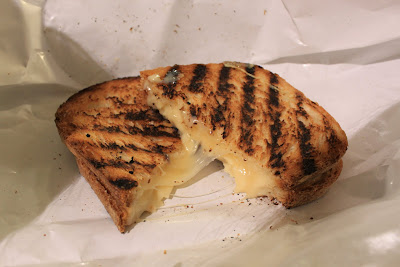Japanese restaurants in Hong Kong are like burger joints, there's always a kaiten (Round-about) sushi restaurant or an Izakaya lurking around every mall or corner you take. It's no surprise that there's an abundance of Japanese cuisine variety, there's the shabu-shabu, sushi restaurants, izakaya, sukiyaki, yoshoku, noodle houses, okomiyaki/takoyaki, even Japanese-style burgers (MOS and Freshness burger), you name it, and we'll have it all here in Hong Kong. Being such a small city, Hong Kong has a large responsibility for serving the 7 million residents here PLUS all the tourists. In 2007, there was approxmiately
9720 sit-in restaurants. So technically speaking, if I tried 3 new restaurants a day, it would take me 9 years to accomplish this task! (Now don't even get me started on Japan.. they have over 20,000 just in Tokyo) Getting to my point, there's only THREE Okinawan restaurants in Hong Kong. I remember absolutely LOVING the food when I was in Okinawa, that was my first accquaintence with Onsen Egg (drooling just thinking about this), Goya (bitter melon that wasn't bitter at all), Umi-budo (tiny grape-like seaweed that is very much like caviar). I absolutely fell in love with the above when I was there, all of which can't be found made nearly as delicious anywhere else. Considering the large population and their undying love for Japanese food, it really made me curious why that was the case... so off I go for my first investigation.
Chura is my first stop, located on one of the busiest streets of Tsim Sha Tsui (Tourists galore!). It's located in the basement of Toy House building (it's quite a discreet yet interesting Japanese-style office building with statues of the Ninja Turtle hidden in the dim lobby), the basement is shared with another Japanese restaurant (Tonkichi) that is strikingly popular, serving Tonkatsu (fried pork) with rice, which I will happily make another trip just to take pictures for my readers.
On a Friday night, while passing by Tonkichi to reach Chura, there was a massive waiting line (approxmiately 2 hour wait), no one was standing outside Chura. A little scared but determined to accomplish this investigation, we stormed in. With intricate decor, running water and stone paths, the bright lighting conveyed a welcoming message. In we went, seated in an intimate booth close to the kitchen.
We ordered a number of dishes, of which included umi-budo, daikon salad, lotus root cake, deep-fried seaweed tempura, grilled saba and squid-ink pan fried noodles with Kurobuta pork.
The umi-budo served on ice is my favorite, I just couldn't stop munching on them! With minimal dressing(just a special soya sauce), they were refreshing and something unique. Hey it's vegetarian caviar without the torture of the poor Beluga's and it's extremely healthy too, what's there not to like about this?
The daikon salad was just the plain ol' "daikon salad" you can get at pretty much any Japanese restaurant.
The lotus root cake was deep fried with pork. The combination tastes like it's very 'Chinese-influenced', as there's a Chinese cuisine that essentially is comprised of the same ingredients, lotus root and pork. The lotus root was very juicy, thus no sauce was needed. I think the lotus root cake would probably taste good even without the pork, although it does have it's distinctive flavours when mixed together.
We had the Seaweed tempura next. This dish, I didn't like at all. The seaweed was very starchy and tasted like a deep-fried "sponge". Crispy on the outside and a flavourless sponge on the inside. Not exactly my cup of tea. At this point, I was starting to realize why this restaurant isn't as popular as the one next door.
Finally, we had the squid-ink pan fried noodles with Kurobuta pork. Doesn't sound Chinese-influenced at all, except for the pan-fried part right? WRONG.. It tasted like pan-fried Shanghainese noodles except with black noodles instead of the tan coloured noodles. Pork, being one of the main ingredients in Japanese cuisines (as beef is in America), being called
Kurobuta pork, the meat should be tender and very flavourful, HOWEVER (yes, you saw that coming, didn't you?) the "Kurobuta pork" was just like any other pork. The dish just didn't tickle my tastebuds.
Squid ink pan fried noodles with Kurobuta pork
Pan-fried Shanghainese noodles
After all that, the three of us decided that the dishes were too small and we were not yet satisfied (even went next door for dessert after this!), so we ordered a grilled saba. This was ho-hum, nothing exciting, the typical grilled fish from any Japanese restaurant.
Verdict from my first investigation: The Okinawan dishes are mainly Chinese-inspired except for the umi-budo. Afterall, being in Hong Kong, why would you go to a Japanese restaurant for Chinese-inspired dishes? The Japanese dishes were not exceptionally good, the deep-fried seaweed tastes nothing like it does in Okinawa. Basically, if this was my only accquaintence with Okinawa food, I probably wouldn't be too excited about trying other Okinawan restaurants.
I still have two more chances of hope in revisiting my memories of Okinawa right here in Hong Kong. I hope I have good news to announce soon!
Chura - Unit A, B/F, The Toy House, 100 Canton Rd., Tsim Sha Tsui, 3105-8950







































